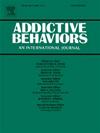Examining the individual and combined influence of negative affect and nicotine cue provocation on craving to vape nicotine among e-cigarette users
IF 3.6
2区 医学
Q1 PSYCHOLOGY, CLINICAL
引用次数: 0
Abstract
Identifying cues for craving to vape (nicotine) in e-cigarette users can inform cessation treatments. Both proximal (e.g., holding e-cigarette) and distal (e.g., smoking environment images) environmental cues and negative affective cues can elicit nicotine craving. Virtual reality (VR) environments provide an efficient, replicable method for cue exposure with a high degree of realism, and lends itself to studying the additive or interactive effects of negative affect on cue reactivity. The current study examined the effects of cue provocation in negative and neutral affect contexts among 50 e-cigarette users. Our fully-within subject design examined the factorial combination of these internal (negative affect induction or not) and external (proximal or distal nicotine) cues. We hypothesized exposure to both in vivo proximal cues (holding e-cigarette) and distal cues presented via a VR headset (social smoking environment) would induce cravings to vape nicotine. Furthermore, we expected induced negative affect would produce higher cravings to vape nicotine compared to their natural affective state. Finally, we hypothesized an interaction between affective and nicotine vaping cues, with participants showing the greatest reactivity to cues following negative affect induction. We found that affective and external cue exposure had additive but not interactive effects on craving to vape nicotine, with evidence that both in vivo (proximal vaping cues) and VR headset-based (distal smoking cues) led to increased cravings. These findings demonstrate the efficacy of VR headset-presented cues on cravings to vape nicotine among e-cigarette users and show that negative affect induction can have additive effects on cue-induced craving.
考察负面情绪和尼古丁线索刺激对电子烟使用者尼古丁渴望的个体和综合影响
识别电子烟使用者渴望vape(尼古丁)的线索可以为戒烟治疗提供信息。近端环境线索(例如,手持电子烟)和远端环境线索(例如,吸烟环境图像)和负面情感线索都可以引发尼古丁渴望。虚拟现实(VR)环境为线索暴露提供了一种高效、可复制的方法,具有高度的真实感,并适合于研究负面影响对线索反应性的附加或交互效应。目前的研究调查了50名电子烟使用者在消极和中性影响环境下的提示挑衅的影响。我们的全内受试者设计检查了这些内部(负面影响诱导与否)和外部(近端或远端尼古丁)线索的因子组合。我们假设暴露于体内近端提示(拿着电子烟)和远端提示(通过VR耳机呈现的社交吸烟环境)会诱发对电子烟尼古丁的渴望。此外,我们预计诱导的负面情绪会比他们的自然情绪状态产生更高的对尼古丁的渴望。最后,我们假设情感和尼古丁电子烟提示之间存在相互作用,参与者在消极情感诱导后对提示表现出最大的反应。我们发现,情感和外部线索暴露对电子烟尼古丁的渴望具有叠加效应,但不是相互作用,有证据表明,体内(近端电子烟线索)和基于VR耳机的(远端吸烟线索)都会导致渴望增加。这些发现证明了VR头显提示对电子烟使用者对尼古丁渴望的有效性,并表明负面影响诱导可以对提示诱导的渴望产生叠加效应。
本文章由计算机程序翻译,如有差异,请以英文原文为准。
求助全文
约1分钟内获得全文
求助全文
来源期刊

Addictive behaviors
医学-药物滥用
CiteScore
8.40
自引率
4.50%
发文量
283
审稿时长
46 days
期刊介绍:
Addictive Behaviors is an international peer-reviewed journal publishing high quality human research on addictive behaviors and disorders since 1975. The journal accepts submissions of full-length papers and short communications on substance-related addictions such as the abuse of alcohol, drugs and nicotine, and behavioral addictions involving gambling and technology. We primarily publish behavioral and psychosocial research but our articles span the fields of psychology, sociology, psychiatry, epidemiology, social policy, medicine, pharmacology and neuroscience. While theoretical orientations are diverse, the emphasis of the journal is primarily empirical. That is, sound experimental design combined with valid, reliable assessment and evaluation procedures are a requisite for acceptance. However, innovative and empirically oriented case studies that might encourage new lines of inquiry are accepted as well. Studies that clearly contribute to current knowledge of etiology, prevention, social policy or treatment are given priority. Scholarly commentaries on topical issues, systematic reviews, and mini reviews are encouraged. We especially welcome multimedia papers that incorporate video or audio components to better display methodology or findings.
Studies can also be submitted to Addictive Behaviors? companion title, the open access journal Addictive Behaviors Reports, which has a particular interest in ''non-traditional'', innovative and empirically-oriented research such as negative/null data papers, replication studies, case reports on novel treatments, and cross-cultural research.
 求助内容:
求助内容: 应助结果提醒方式:
应助结果提醒方式:


